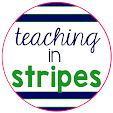If your students are any thing like mine, they struggle with making inferences. It is a tricky skill! ...and it takes a lot of practice. I made something super fun for my second graders, and they didn't even realize how hard they were working on making inferences.
In summary, students use the items in the garbage cans to infer who the garbage can belonged to.
I started my lesson by showing the Brain Pop Jr. video titled, "Make Inferences". (Brain Pop is a paid subscription that I am lucky to have in my District. If you don't subscribe, it is definitely worth the money. I use it so often!) I referred to my Inferring anchor charts (shown above). I love having premade anchor charts to refer to when creating the anchor chart is not the focus of my lesson. (This set is can be found here.) I always teach inferences as filling in the blanks. The author wants the reader to think about the text and to draw his or her own conclusions. Then, to help students get the idea of using object clues to make inferences, we did a premade practice worksheet starring some famous characters. You can grab this worksheet for free here or by clicking on the photo above.
I put a garbage can on each of my student tables. After explaining the activity to the students, they went from table to table to inspect the contents of the garbage can. They recorded a list of the contents on the graphic organizer that I provided for them. This was considered the evidence or text clues. Then, students wrote down some of the background knowledge they had about their teachers. Some chose to fill out the entire thing while at the table, and some chose to observe first and infer later. This took about 15 minutes. The activity followed the same procedure that we used when we were learning to make inferences in a text: read, think about what you already know/schema, and then infer.
Finally, we came together and created a whole-group anchor chart using the information that students had recorded. We recorded the evidence. They gave me their inference, and then they explained why they chose that particular teacher. It was so fun to hear their rationalization about why a certain can had to belong to a certain teacher. So cute and funny! I also revealed the owners of the garbage cans, and they had gotten them all correct! They definitely know their 2nd grade teachers pretty well. It was so much fun!
If you need help or suggestions, there is a list of ideas included in my resource.
I rewarded the students for their hard work with some cute brag tags and completion certificates, which of course they loved. They are crazy for brag tags!
I put this activity together in one resource for you, if you're interested in trying in your own classroom. It includes everything that you need, minus the items for the trashcans. The recording sheets are editable so you can customize it for yourself and your classroom. You can grab it here or click on the picture below. You don't need the resource to do the activity, though! You could do it really simply without the extras. Have fun with this activity! It's a really great way to hook your little readers!








































